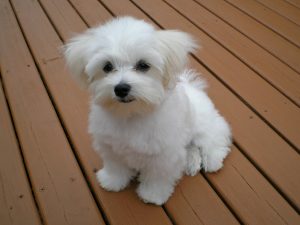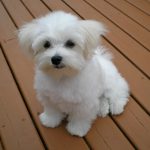Nature of Tear Stains
 Whenever hair rests around the eyes some amount of tear staining results from the hair wicking moisture from the eyes. But there are many other sources of tear stains. Tear staining can be traced to health and diet, as well as genetics. Most veterinarians agree that face staining results from excessive tearing. In this case, the damp face hair is a breeding ground for bacterial and yeast growth. The most common is “Red Yeast” which is usually associated with reddish-brown facial stains, and which may emit a moderate to noticeably strong odor. Tear ducts may become infected and result in excess tearing and noticeable staining. Some doctors advise that the eye structure was the most probable source of the problem. If that is so, then genetics would likely play a role and explain why the problem is more pronounced in some pets of the same breed.
Whenever hair rests around the eyes some amount of tear staining results from the hair wicking moisture from the eyes. But there are many other sources of tear stains. Tear staining can be traced to health and diet, as well as genetics. Most veterinarians agree that face staining results from excessive tearing. In this case, the damp face hair is a breeding ground for bacterial and yeast growth. The most common is “Red Yeast” which is usually associated with reddish-brown facial stains, and which may emit a moderate to noticeably strong odor. Tear ducts may become infected and result in excess tearing and noticeable staining. Some doctors advise that the eye structure was the most probable source of the problem. If that is so, then genetics would likely play a role and explain why the problem is more pronounced in some pets of the same breed.
If you are purchasing a puppy and you are concerned about the potential for tearing and staining, you should observe the mother and sire, and others in the direct lineage. Eye duct surgical procedures to increase their tear capacity may help some pets; ask your veterinarian. If bacterial and yeast infections are involved you need to take steps to mollify and eliminate their presence. Veterinarians can prescribe medication to treat bacterial and yeast infections. Your veterinarian or eye specialist veterinarians can determine if excessive tearing is the source of stains, and describe alternatives available.
Tear staining in the dog and especially in the small breeds (Poodles, Maltese, Bichons, Pekes ) is common but should never be called “normal.” The reality is that these breeds have tiny hairs in the inner aspect of the lid margin that acts as wicks for tear accumulation. As well, the tear film is constantly evaporating and in a number of breeds there is overproduction of tears. The tear ducts which carry the tears down into the nasal cavity, in general, are totally functional. It is rare that the tear ducts are non-functional. Treatment is variable – the area in which the tears are stored can be deepened surgically; the hairs around the inner aspect which are causing irritation can be moved out of the way and there are a few other alternatives as well. Oral medication has been suggested as a means of chemically changing the metabolism of the tears and making the staining less apparent. Treating the skin irritation where the tears flow onto the face should also be considered. In all cases the ophthalmologist should see the animal to give the pet owner the best of all the alternatives.
Hair coat stains also occur in areas other than the eyes. White and light color coats, wrinkled faces and short nosed breeds like our beloved bulldog can acquire water stains from pet drinking water, bacteria and red or pimple looking bumps may appear as well, try using a stainless steel bowl for food and water and clean at least 3 times weekly in a dishwasher to sterilize them. Minerals in the water may stain facial hair in the whisker, and mouth areas, as well as other areas on the chest and front legs when water regular drips. Purified waters/bottled water with low mineral content may be the answer.
Ear infection or ear mites can cause the staining as well. Cleaning the ear after every bath is very important. I do not use a drying powder but have heard that they can be useful. If there is any dark discolor or yellowing of the coat around the ear hair this is a good sign of an ear problem.
Some pet foods with certain additives will stain hair in the mouth area, HOWEVER BEET PULP WILL NOT CAUSE TEAR STAINS, that is mis-information to assume it will. Beet pulp used in dog foods and treats are “sugar” beets, they are white, not red and do not contribute to tear stains.
Your first step is to determine the source of tear and face stains. As we have noted, it may be water and food sources and that can be corrected. Tear staining often involves more complex solutions requiring veterinary introspection to determine the source.
If bacterial and yeast infections are involved you need to take steps to reduce and eliminate their presence. Veterinarians can prescribe medication to treat bacterial and yeast infections. Your veterinarian or eye specialist veterinarians can determine if excessive tearing is the source of stains, and describe alternatives available.
Tear Stain Removal
Tear stain removal has become much easier with various products now on the market just for this purpose. There are tear stain home remedies using mixtures of milk of magnesia, corn starch and peroxide, or bleach (usually hydrogen peroxide) used for human hair. However, if you were not to mix these properly, use precisely the right strength of each ingredient, and apply them safely, you could potentially harm your dog. No solution should ever be splashed into the pet’s eye, or allowed to wick through the facial hair into the eye area. Read and follow all instructions very carefully. Keep in mind that you are treating the eye area of your pet and you can harm their sensitive areas. A full amount of caution and concern must be exercised whenever you use any product or mixture near eyes.
Keeping tear stains at minimum is more of a concern for dogs that are shown, and for the dog not being shown, taking steps to safely minimize the condition should be satisfying enough rather than complete elimination. Consult your veterinarian with any questions you may have.
Tetracycline
Consult your vet for this method as it requires a RX anyway. This method should only be used when all others have failed and should only be used for 1-2 courses of treatment and not relied on as a continued treatment. Some have found success in eliminating tear staining by putting a Maltese on a ten day course of low dose tetracycline. Occasionally this may need to be repeated. Do not use this in puppies that have not yet cut their adult teeth. Tetracycline has been shown to cause teeth which have not erupted to permanently stain yellow.
TUMS
If you need to change the pH of your dogs system to aid in preventing yeast or infection then Tums is primarily a source of Calcium, known as an antacid formulated as 500 mg Calcium Carbonate. Giving your Maltese 1/2 of the Fruit flavored variety twice a day will help change the pH of the tears. This will change the tears’ environment and can help make it hostile for the continued growth of yeast and bacteria.
White Vinegar
A teaspoon of white cider vinegar can be added to your dogs drinking water to control new tear stains. It may take a while for your dog to “decide” to drink this water so start with a little less and gradually increase the amount of vinegar.
Vinegar works much like TUMS in that it can changes the pH of the drinking water. Changing the pH of your dog slightly will do wonders in the tear stain war and help eliminate bacteria and deep stain color and prevent yeast build up and is best used as a prevention once you have the tear stains removed or nearly removed. This will help for the future of the tear stains and make them a minimum occurrence.
Milk of Magnesia, corn starch and peroxide
Use equal volume of MOM (plain white) and peroxide, and then use the corn starch to make a good paste of this; put on and work well into the stained area and let dry 4 hours. Wash out, CONDITION WELL. Keep doing this for several days until tear staining is gone, although I would recommend skipping a day or two between applications if possible. Apply a thin coat of desitan diaper rash ointment after the area is washed out and dry. Try this every other day if possible and the choice way of doing it. If your dog has heavy stains then do this for 3 days in a row, then skip every other day.
Corn Starch and Peroxide
Make a paste with corn starch and peroxide, apply with a small toothbrush, leave overnight and remove it with warm water or peroxide in the morning.
Angel Eyes
Is a product that has tylan an antibiotic in it and it works wonders to clear up the tear stains. Be sure you are not going to be taking your dog in for a liver check before placing on the Angel Eyes because it can and will most of the time give back false negatives. It does not cause any harm to the liver. Just causes a false negative. Also please be sure you dog has cut all it’s baby teeth before starting this treatment. The Tylan that is in it is very likely to cause the adult teeth
to stain if they have not erupted.
Optrex Eye Wash
Clean around the eye area with cotton pads moistened with Optrex (contains Boric Acid and Witch Hazel).
Boric Powder, Baby Powder & MOM
Measure equal parts Boric Powder, Baby Powder, mix together with Milk of Magnesia to smooth paste. You can make up a jar full. Apply to affected area with a soft toothbrush, allow to dry then brush off. If badly stained use a few drops of 10% peroxide in paste.
Add one tablespoon Boracic Acid to a cup of boiling water, mix well. Place several cotton swabs into a plastic container. Pour the cooled solution over the swabs and seal the container. Use one swab daily to clean away tear and face staining. Make up a new mix at least once weekly.
Daily Face Wash
One Tablespoon Boric Acid to One Cup Boiling Filtered/Distilled Water
Bring water to a boil, remove from heat and add the Boric Acid stirring until it dissolves. Let cool and place in a squeeze bottle. Make a new batch every week.
Do this every day, squirting on a paper towel to clean the eyes. Keep folding the towel and rewetting with the solution and cleaning until there is no discolouring from the eyes on the towel any longer. Then dry with another paper towel and discard. You could use a washcloth but for hygiene – I prefer paper towels which are disposable and biodegradable.
Boric Acid is most commonly found and recovered in the Tuscan region of Italy, also from Italy’s hot springs and theirvapors. It occurs as the mineral “sassolite” . In the USA, Boric Acid is recovered from brines from the Searles Lake in California. Boric Acid is antiviral and antiseptic and used commonly in the form of an eyewash and controls the browning of tears.
If you clean your dogs eyes every day ( takes a few minutes) you will both be happy and your dog will look lovely. You will prevent many eye conditions if you take a few minutes every day to clean the face. Boric Acid should not be used in a powdered form directly on the eyes – if you get it in the eye you will cause it to ulcer.
You should also make sure your dog does not have a tear duct obstruction (blockage) and have corrected the food and water issue first so he don’t keep getting tear stains. After all if you treat the tear stains to remove them while at the same time you feed a food that causes tear stains you won’t gain nothing. Try the least invasive of the above methods first, give them 2-4 weeks to work, then if your not satisfied go to another method of treatment. Do not use multiple treatments at the same time. Always have your vet give the dog a complete exam to rule out any serious eye condition first before trying anything else. The commercial products just don’t work very well so it is best to just forget about them unless you have a very mild case of stain.
 When you get your new puppy home, he/she should be at least 12 weeks old. Your puppy may be even older – depending of the size and the general health of the puppy. Once in your home, you will need to give them access to food at all time. A new puppy should always have dry food available to them (I feed Bil Jac puppy and Royal Canin , or Iams Holistic puppy formula). I prefer the Bil Jac puppy at first because it is very easy to make a nice ‘wet mixture” with quickly. The Bil Jac pellets will crumble in your hand easily and the puppies love them. I will also feed them a wet mixture at least once a day. If the puppy is very tiny, I will feed two wet mixtures a day. I have also found the Little Caeser Puppy can food has become a favorite of my puppies and my adults who are either nursing or pregnant. This is very easy to find, you can locate Little Caesar’s at your local grocery store or Walmart. Little Ceasar’s can also be mixed in with your puppy’s dry food to get them to eat. Mix ½ can to ¼ cup of dry kibble. The puppy will scarf this right up.
When you get your new puppy home, he/she should be at least 12 weeks old. Your puppy may be even older – depending of the size and the general health of the puppy. Once in your home, you will need to give them access to food at all time. A new puppy should always have dry food available to them (I feed Bil Jac puppy and Royal Canin , or Iams Holistic puppy formula). I prefer the Bil Jac puppy at first because it is very easy to make a nice ‘wet mixture” with quickly. The Bil Jac pellets will crumble in your hand easily and the puppies love them. I will also feed them a wet mixture at least once a day. If the puppy is very tiny, I will feed two wet mixtures a day. I have also found the Little Caeser Puppy can food has become a favorite of my puppies and my adults who are either nursing or pregnant. This is very easy to find, you can locate Little Caesar’s at your local grocery store or Walmart. Little Ceasar’s can also be mixed in with your puppy’s dry food to get them to eat. Mix ½ can to ¼ cup of dry kibble. The puppy will scarf this right up. ~ The Breeder keeps alert of any inherited problems that are particular to their breed. They strive to screen their breeding stock for hereditary problems using the current available and generally accepted techniques.
~ The Breeder keeps alert of any inherited problems that are particular to their breed. They strive to screen their breeding stock for hereditary problems using the current available and generally accepted techniques. People have been enjoying the company of Maltese dogs for thousands of years, the origin of this lively toy breed being dated between 6,000 BC and 8,000 BC and credited to the Central Mediterranean area. The Maltese is thought to be bred from Spitz-type dogs and was selectively bred for a smaller size and long, soft fur. Official kennel clubs began recognizing this breed in 1898 and gave it its name in honor of the Island of Malta where many believed the breed originated. Recent years have brought on the creation of the Teacup Maltese, bred to be smaller than the original Maltese.
People have been enjoying the company of Maltese dogs for thousands of years, the origin of this lively toy breed being dated between 6,000 BC and 8,000 BC and credited to the Central Mediterranean area. The Maltese is thought to be bred from Spitz-type dogs and was selectively bred for a smaller size and long, soft fur. Official kennel clubs began recognizing this breed in 1898 and gave it its name in honor of the Island of Malta where many believed the breed originated. Recent years have brought on the creation of the Teacup Maltese, bred to be smaller than the original Maltese. The Maltese breed of dogs is a breed of gentle, playful and smart dogs. The miniature Maltese is that, plus more, and fun-sized! These bite-size poochies are almost identical to their larger predecessors, however, their personalities are sometimes even larger! Even a skilled trainer or experienced owner of full-sized Maltese dogs can stand to learn something new about the miniature Maltese. No matter their similarities, the mini Maltese is still a completely different animal than the average Maltese. The following tips, advice, and guidelines include everything you need to know about the miniature Maltese.
The Maltese breed of dogs is a breed of gentle, playful and smart dogs. The miniature Maltese is that, plus more, and fun-sized! These bite-size poochies are almost identical to their larger predecessors, however, their personalities are sometimes even larger! Even a skilled trainer or experienced owner of full-sized Maltese dogs can stand to learn something new about the miniature Maltese. No matter their similarities, the mini Maltese is still a completely different animal than the average Maltese. The following tips, advice, and guidelines include everything you need to know about the miniature Maltese. The Maltese is one of the oldest dog breeds known to mankind and has been a companion animal for the entirety of its heritage. While these small dogs are well-known for being associated with aristocracy and living lavish lives, Maltese temperaments are actually quite spirited and playful. Even throughout their old age, Maltese remain active and energetic.
The Maltese is one of the oldest dog breeds known to mankind and has been a companion animal for the entirety of its heritage. While these small dogs are well-known for being associated with aristocracy and living lavish lives, Maltese temperaments are actually quite spirited and playful. Even throughout their old age, Maltese remain active and energetic.







